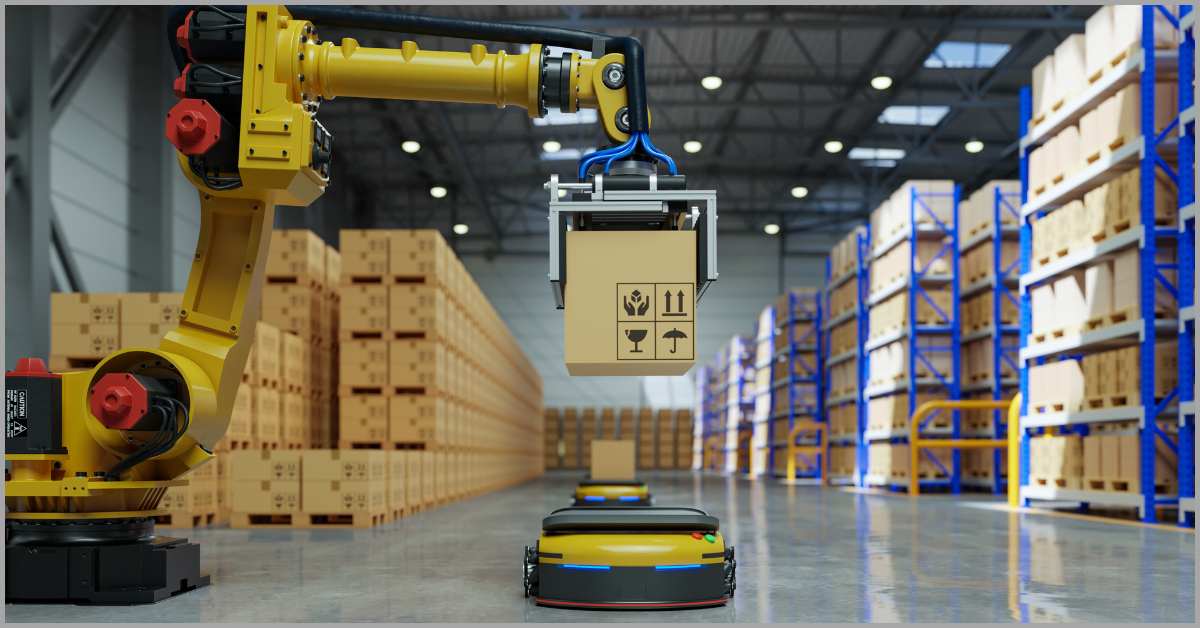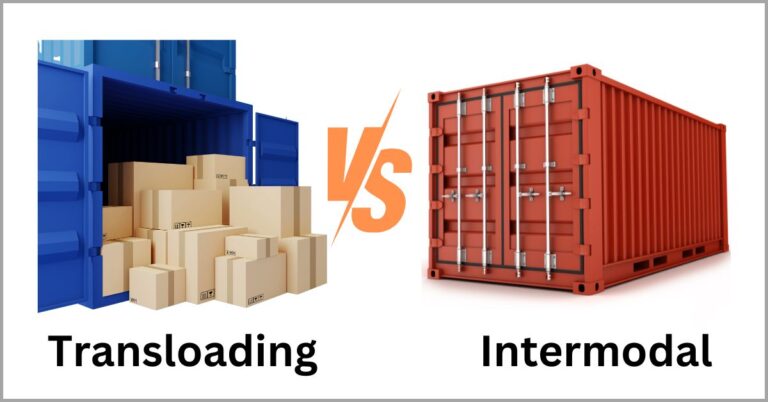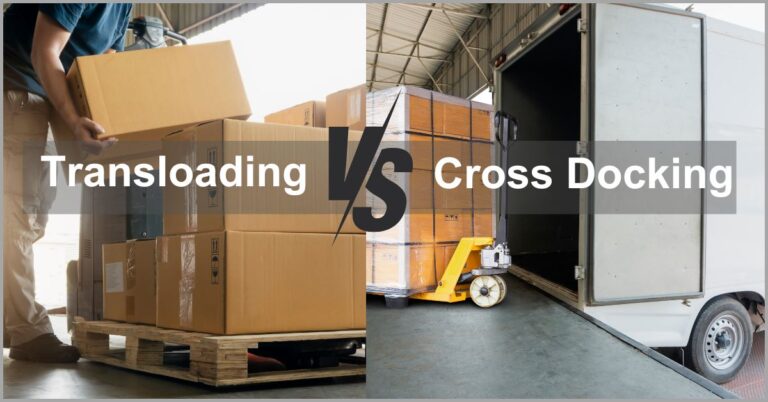100 Warehouse Management & Automation Statistics to Guide Your Operations in 2024
Keen to improve warehouse operations?
If you’d like to run or start a successful warehouse business, automation is essential.
When your business is bogged down by too many manual and iterative tasks, this can reduce worker productivity and lead to lower turnaround times.
A Bizagi study revealed that manual tasks consume 50% of work hours for a third of logistics workers. That’s half a workday spent inefficiently.
In order to help you elevate efficiency and minimize productivity losses for your warehouse, I’ve compiled these important warehouse automation statistics that will help you learn key areas of your operations that are most eligible for automation.
You’ll also get wind of high-potential technologies to adopt for picking, putaway and other important aspects of your workflow to enhance critical warehouse operations.
If you’d like to master warehouse shipping strategies for meeting diverse client needs, check out this article I wrote on transloading vs transshipment shipping approaches.
In this article, we’ll discuss warehouse management & automation statistics to streamline your operations in 2024 and help you generate more revenue.
Let’s get started.
I. General warehouse management statistics
What’s new when it comes to warehouse management?
Understanding the latest warehouse management trends is key to helping you run your warehouse more efficiently. This knowledge can also help you capitalize on opportunities to accelerate growth and make your warehouse more resilient.
So in this section, we’ll discuss warehouse management statistics to help increase success for your business:
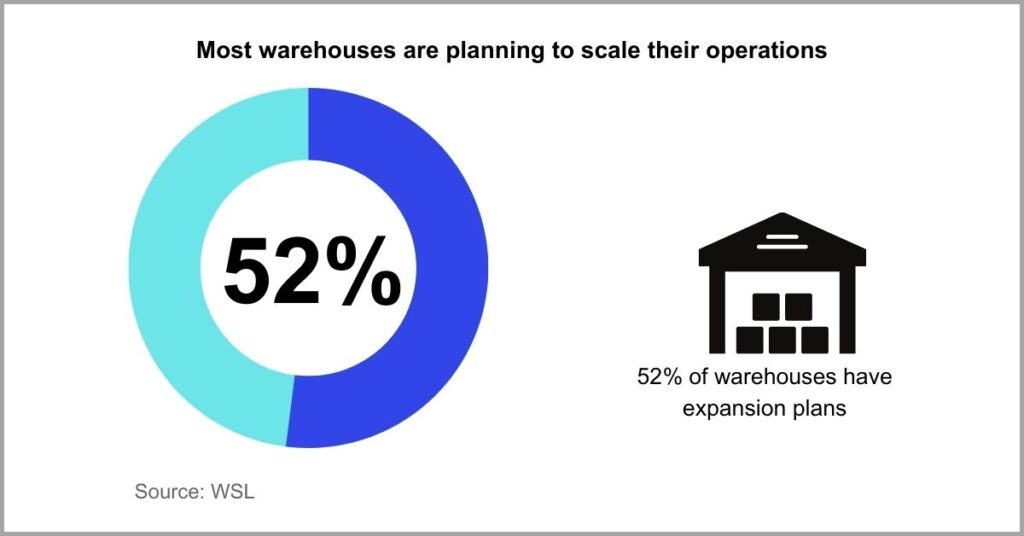
1) 32% of warehouses operate in the ecommerce space. Ecommore has been growing in recent years due to the increasing popularity of online shipping, which is why we’re seeing warehouse businesses focus on the industry. (Source – WSL)
2) 27% of warehouse businesses serve wholesale purposes. This is a type of warehouse where you store goods in large quantities to distribute to retailers and other small stores who then sell to the consumer. (Source – WSL)
3) 24% of warehouses serve manufacturing purposes. If you produce your own products, you may have a manufacturing warehouse where you store large amounts of raw materials, product parts and even sem-finished products. (Source – WSL)
4) 52% of warehouses said that they aim to invest more in expanding their businesses in the coming years. Keeping in mind the economies of scale, growing your operations can attract more cost-savings and greater profits. (Source – WSL)
5) 21% of businesses fully use their warehouse to manage customer-owned inventory, while 4% do so partially. These warehouse management statistics tell us that a good number of businesses are using their storage facilities to provide third-party logistics. (Source – Software Connect)
6) 51% of companies track between 1,000 and 10,000 SKUs or stock keeping units. An SKU is basically a number that you assign to materials or stock in your warehouse, usually via a barcode label, to make items easier to rack. (Source – Software Connect)
7) 82% of businesses said they’ll expand the number of warehouses they use within the next five years. If pulled off strategically, it’s a move that can help you improve supply chain flexibility and ensure more efficient order fulfillment. (Source – Zebra Technologies)
8) 80% of warehouses plan to add more valued added services to attract clients. Some profitable business ideas you can exploit in this regard include providing transloading, freight forwarding, through trailer and freight brokerage services. (Source – Zebra Technologies)
9) 78% of supply chain experts leverage dual-sourcing strategies to secure critical raw materials for their warehouse. This is a tactic where you source goods from two manufacturers simultaneously to reduce supply chain risks. (Source – McKinsey)
10) 37% of businesses use scenario planning to improve their warehousing and logistics operations at large. Also known as scenario analytics, it’s a strategy that involves predicting and preparing for each outcome of a business decision. (Source – McKinsey)
II. Statistics on challenges of warehouse management
Running a warehouse isn’t always smooth sailing.
From labor shortages and increasing rent fees to key transloading challenges such as accidents and freight damage, there are many obstacles that can hamper efficiency and profitability for your workflow.
In this section, we’ll discuss these challenges to help you protect your business better:

11) 59% of managers said that the biggest challenge their warehouse faces is attracting and finding a qualified workforce. Some of the leading reasons include a biting talent shortage and the industry’s high workforce turnover rate. (Source – Statista)
12) 36% of warehouses highlighted insufficient space for inventory as the most pressing issue in their operations. A key driver behind these warehouse management statistics is poor space utilization due to inefficiency pallet stacking strategies. (Source – Statista)
13) 36% of businesses identified outdated equipment as the biggest threat they face. In particular, the biggest pain points in this regard revolved around legacy materials and picking equipment that made warehouse workers less productive. (Source – Statista)
14) 21% of organizations said poor information systems support is a top struggle. When it’s hard to find timely information in your warehouse, this can lead to a slower turn around time that increases customer frustrations and erodes trust. (Source – Statista)
15) 45% of warehouses identified supply chain disruptions as the biggest threat to their company. Some common causes behind these disruptions include geopolitical factors, disease outbreaks, port congestion and fluctuating demand. (Source – Hopstack)
16) 57% of businesses rated improving warehouse worker productivity as the top challenge. Some of the common causes of productivity loss for your warehouse include poor communication, bad floor layouts and insufficient training. (Source – Karadex)
17) 64% of organizations ranked cyber crime among the largest hurdles in their warehousing operations. I recommend investing in warehouse management systems with advanced security controls to safeguard against advanced digital threats. (Source – Logistics Hall of Fame)
18) 18% of warehouses cited climate change as a significant concern for their business. It may not be among the warehouse management statistics that get a lot of attention, but prioritizing eco-friendly operations can improve your brand’s image. (Source – Logistics Hall of Fame)
19) 22% of managers said picking was the most problematic area of managing their warehouses. In particular, they identified picking errors and accuracy as some of the biggest obstacles that are ruining efficiency for their business. (Source – BlueStar)
20) 17% of businesses admitted to putaway being a thorn in the side of their warehouse operations. If you’d like to optimize your putaway processes, I recommend using a modern warehouse management system and leveraging data analytics as well. (Source – BlueStar)
III. Statistics about warehouse management systems
So what is a warehouse management system (WMS)?
It refers to any software or platform that lets you manage and control daily warehouse operations to optimize the flow of goods and make shipping more efficient.
Click here to start your free transloads.co trial to boost warehouse efficiency.
Our transload WMS can help you improve inventory management, get more out of your workers, and elevate productivity and revenue for your transloading warehouse.
That said, I’ve rounded up these warehouse management system statistics for you:
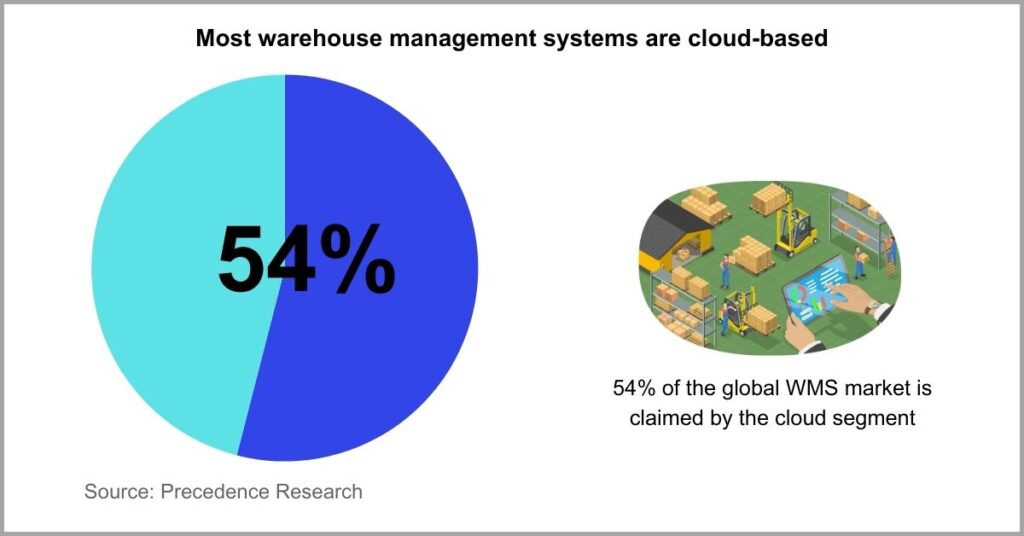
21) 19.52% of is the compound annual growth rate (CAGR) of the warehouse management system market between 2024 and 2033. This shows that warehouses will continue to invest more in these technologies going forward. (Source – Precedence Research)
22) $23.62 billion is the forecasted size of the global warehouse management system market by 2033, up from $4.74 billion in 2024. Growing economies and wide-spread adoption across various industries are credited for fueling this rapid expansion. (Source – Precedence Research)
23) 33% of the warehouse management system market’s revenue came in from Europe in 2023. As a result, it held the largest share of the global WMS market, showing that it may be a great target region if you’re a provider of these technologies. (Source – Precedence Research)
24) 54% of the revenue share of the global WMS is credited to the cloud segment. So that means that more than half of businesses have embraced cloud-based warehouse management tools, which I recommend for their excellent scalability. (Source – Precedence Research)
25) 84% of businesses said they used a WMS in 2023, compared to 79% in 2022. These are very promising warehouse management system statistics that show businesses are beginning to recognize the potential of the technology. (Source – Logistics Management)
26) 51% of warehouses admitted that one of the main reasons for using a WMS was to automate data collection. With these tools, you can get automated real-time information about various warehouse aspects to minimize manual data tracking. (Source – Logistics Management)
27) 81.23% of the WMS market revenue came in from the services segment in 2023, marking the largest segment by component. Services here entails WMS system integration services, maintenance services and technology consulting. (Source – GVR)
28) 20.1% is the CAGR of the cloud segment of the warehouse management system market between 2024 to 2030. This shouldn’t come as a surprise really given the many advantages this form of deployment type has over on-premise solutions. (Source – GVR)
29) 82% of large supply chain organizations leverage warehouse management systems and other logistics tools. This is above the average adoption rate across industries, proving that large companies are bigger adopters of WMS systems. (Source – FBI)
30) In 2023, the manufacturing sector accounted for 13% of the warehouse management system market in the US. As a result, it’s among the industries with the highest adoption rates for WMS solutions. (Source – FBI)
IV. Statistics about warehouse automation
Automation is the cornerstone of success.
Beyond helping you to get around common warehouse challenges, automation can also help you capitalize on other profitable warehouse business ideas so you can expand your offerings and your revenue.
For more details, I’ve rounded up vital warehouse automation statistics you should check out:
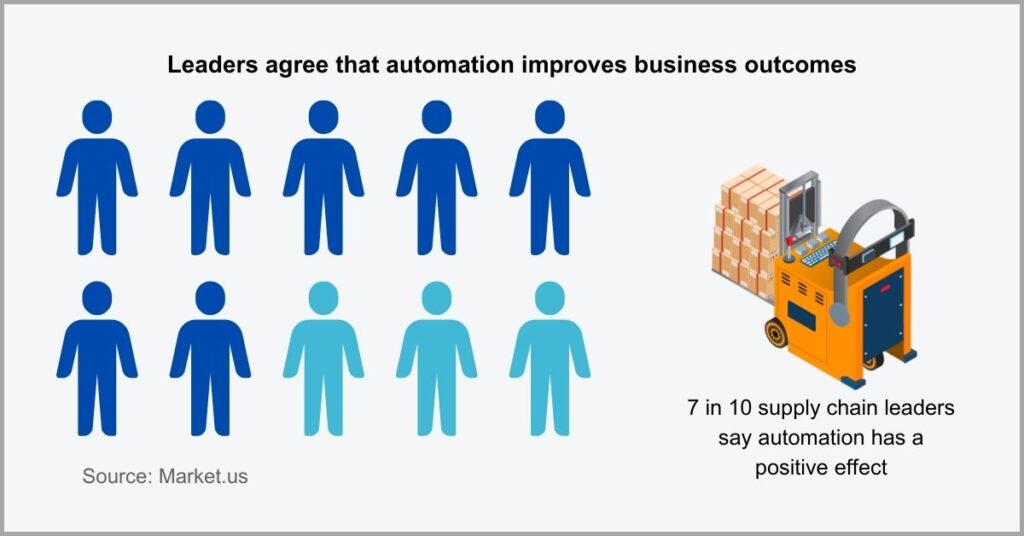
31) 68% of businesses said they’re accelerating warehouse modernization efforts thanks to automation. If your warehouse is to stay competitive in today’s cut-throat logistics scene, automation needs to be part of your workflow. (Source – Bizagi)
32) 86% of warehouses have automated storage and retrieval systems in place in 2024 or are making plans to get them. These technologies can help you automate very time-intensive tasks for your warehouse such as putaway. (Source – AutoStore)
33) 28% of businesses said investing in automation is the biggest priority for their warehouses. This makes it the joint top objective for logistics businesses, alongside improving customer satisfaction and retention. (Source – AutoStore)
34) 70% of supply chain leaders admitted that automation has a positive impact on warehouse operations. More specifically, they said it helps minimize their outsourcing needs, therefore increasing profit margins for their business. (Source – Market.us)
35) Transport management accounts for 56% of warehouse automation software usage. From the data I reviewed, this represents the highest use case of warehouse automation, making it a key priority area for most workflows. (Source – Market.us)
36) 77% of warehouses use integrated automated systems primarily to enable data-driven performances. In particular, they centralize data to improve warehouse information visibility in order to guide informed decision-making. (Source – Market.us)
37) 42% of warehouses have automated 20 to 40% of their workflow, while 33% have automated less than 20%. So these warehouse management system statistics tell us that most businesses are in the early adoption stages. (Source – Hopstack)
38) Logistics businesses are set to spend 33% of their capital on warehouse automation by 2027. With these types of organizations typically having very huge warehousing needs, it’s understandable why they’re jumping onto this trend. (Source – Statzon)
39) 49% of organizations reported using significant or total automation in 2023, compared to 61% in 2024. I expect this figure to continue on an upward trajectory as businesses continue to modernize their warehouse operations. (Source – AutoStore)
40) 20% is the average market penetration rate for automated storage and retrieval systems in 2024. However, this number is set to double by 2031 as warehouses intensify their logistics transformation processes. (Source – AutoStore)
V. Warehouse automation benefits statistics
What are the benefits of warehouse automation?
Whether you run a transloading, fulfillment or any other type of warehouse business, automating manual tasks is important because it frees up value time and cost savings.
Click here to get our premium support services to help automate your warehouse.
With our guidance, you can set up an efficient transload warehouse founded on critical automation technologies that help you increase productivity and profits.
If you’d like to learn why automation is crucial, take a look at this data I rounded up:
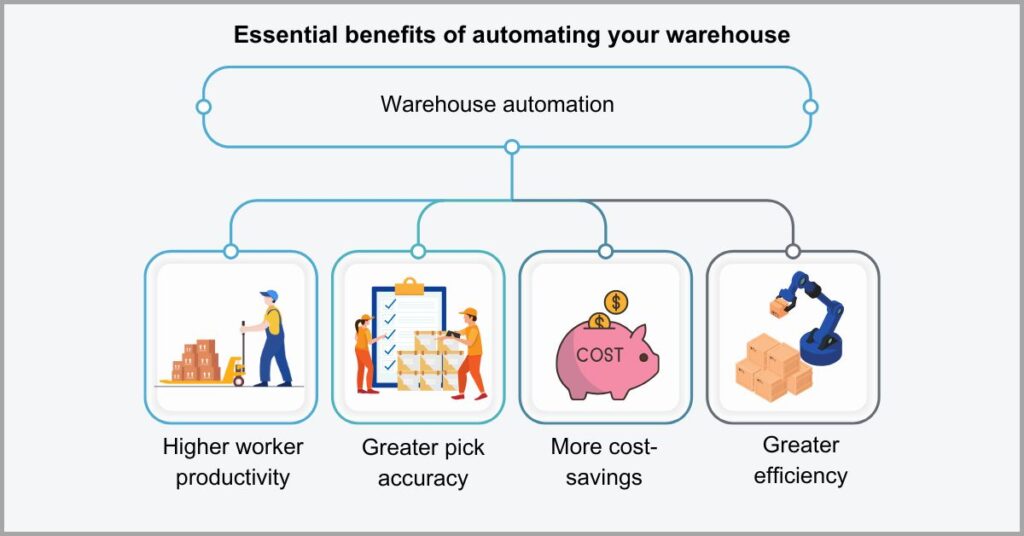
41) 85% is the amount of storage space that you can free up through the use of warehouse automation technologies. So it can help you hold a larger inventory without renting more space, which equates to even more profits. (Source – Karadex)
42) Automation can increase productivity by 66.67% for warehouse workers. By automating iterative work like cycle counting and accelerating picking processes, these technologies enable you to get more work done in less time. (Source – Karadex)
43) It can improve pick accuracy by up to 99.9%. I rate this as one of the most important warehouse automation statistics because it means you can make more accurate order fulfillments, which means fewer reverse logistics to deal with. (Source – Karadex)
44) 90% of managers believe that automation can massively improve warehouse efficiency. I couldn’t agree more with these sentiments, given the benefits of automation that we’ve covered so far, particularly in terms of optimizing space utilization. (Source – Hopstack)
45) 77% of supply chain leaders believe that augmenting workers with technology is the best way to introduce automation in warehouses. So it’s clear that managers believe that automation is for complementing workers rather than replace them (Source – Zebra Technologies)
46) 86% of managers believe that leveraging automation technologies in warehouses can help attract and retain staff. With these tools easing workloads on your workers, it’s understandable why they’d make warehouse jobs more appealing. (Source – Zebra Technologies)
47) 85% is the reduction in lead time for warehouses that have implemented various automation tools. That’s because it can help you optimize inventory management and other time-consuming iterative tasks to expedite order fulfillment. (Source – Bizagi)
48) 45% is the throughput time improvement for businesses that embrace solutions with automated warehouse audit trails. This refers to the entire amount of time it takes to manufacture a product and deliver it to a customer to complete a sale. (Source – Bizagi)
49) 50% of warehouses noticed a reduction in onboarding time thanks to automation. With technologies like all-in-one applicant tracking systems, you can eliminate unnecessary, manual tasks during onboarding so that new staff hit the ground running. (Source – Bizagi)
50) 60% of businesses that implemented automation noticed a reduction in warehousing and supply chain operational costs overall. This data further emphasizes the immense value that automation brings to the table for your business. (Source – Bizagi)
VI. Statistics about warehouse automation technologies
Automation comes in many different forms.
From pick to light systems and collaborative robots to automated guided vehicles and more, there are many existing warehouse management trends you can put to work to improve productivity and safety for your warehouse.
In this section, we’ll explore various warehouse automation statistics to learn what technologies modern warehouses are embracing:
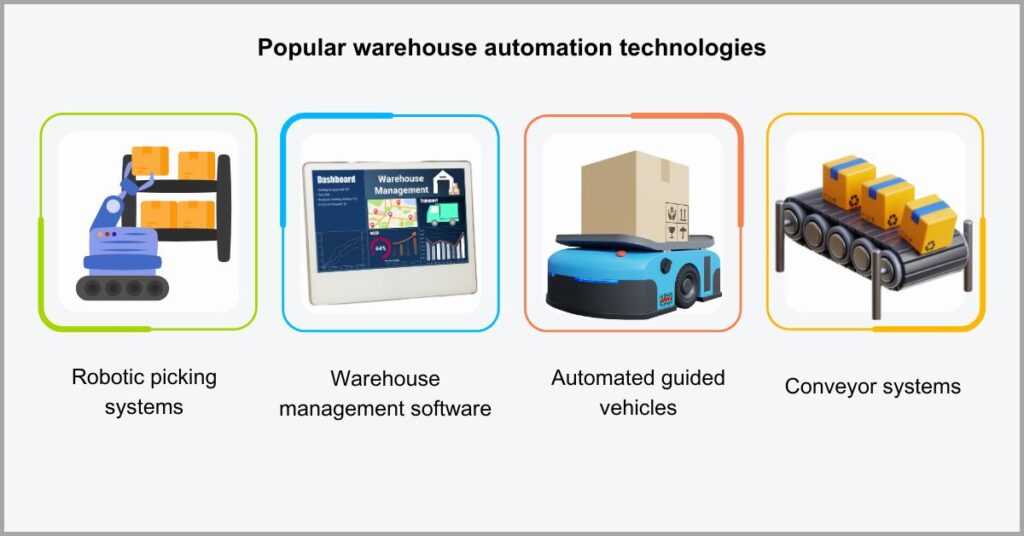
51) 38% of warehouses have adopted robotic picking systems. These robots offer great picking precision and can augment your existing workforce to increase productivity and decrease labor expenses for your warehouse. (Source – Hopstack)
52) 83% of businesses use warehouse management software. This is one of the most critical warehouse management system statistics to take note of, because it means that this is the most adopted automation technology among warehouses. (Source – Statista)
53) 15% of companies have incorporated automated guided vehicles (AGVs) into their warehousing workflow. An AGV is an autonomous vehicle that can carry heavy loads around your warehouse to improve worker efficiency and safety. (Source – Hopstack)
54) 24% of warehouses implemented automated conveyor systems in their workflow. Such tools streamline the movement of goods around your warehouse, and help you to reduce your labor needs and improve space utilization as well. (Source – Hopstack)
55) 23% of businesses confessed they’ve invested in all the four warehouse automation technologies we’ve discussed above. This includes warehouse management systems, AGVs, robotic picking systems and automated conveyors systems. (Source – Hopstack)
56) By 2025, nearly 50,000 warehouses will augment human workers with collaborative robots. This number stood at only 4,000 warehouses in 2019, and shows that businesses recognize the potential of robotics in warehousing. (Source – ABI Research)
57) 43% of warehouses plan to implement automated real-time location systems. This refers to technologies that monitor your warehouse to provide real-time information about the location of inventory items and other warehouse assets. (Source – Zebra Technologies)
58) 36% of companies plan to invest in data automation within the next 5 years. In particular, they’re keen to adopt predictive analytics technologies. This is a prudent strategy that can help you predict demand and optimize inventory levels. (Source – Zebra Technologies)
59) 90% of warehouses plan to adopt supply chain 4.0, which entails IoT & analytics, by 2030, up from 54% in 2019. So this is one of the top warehouse technologies to watch going by the warehouse automation statistics we’ve discussed so far. (Source – Statista)
60) 80% of business leaders plan to implement cloud computing and storage technologies for their warehouses by 2030. Cloud-driven automation is the way to go for your company since it offers a very cost-efficient and highly scalable solution. (Source – Statista)
VII. Statistics about automation adoption challenges
What’s preventing warehouse automation adoption?
If you’d like to become one of the best transload service companies in the industry, understanding automation challenges is key to helping you enact more successful digital transformation initiatives.
So this is why we’ll discuss key automation adoption challenges in this section:
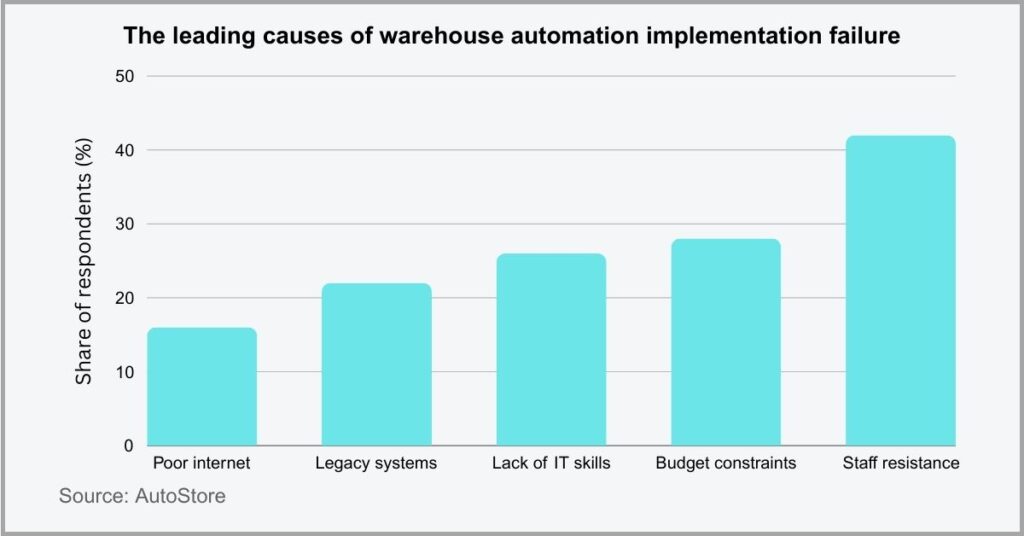
61) 28% of warehouses said budgetary constraints are the biggest hindrance to total automation implementation. These solutions can involve very high upfront costs, however, you can easily recoup your investment from the productivity gains alone. (Source – AutoStore)
62) 26% of businesses blamed a lack of IT skills for their hesitation to adopt automation. From the warehouse automation statistics we’ve looked at so far in this section, this makes up one of the top two biggest adoption challenges alongside budget issues. (Source – AutoStore)
63) 22% of warehouses don’t adopt automation because they’re worried it won’t accommodate their legacy solutions. Before you choose any new technology for your business, make sure it offers seamless compatibility with existing systems to avoid disruptions. (Source – AutoStore)
64) 16% of businesses said a lack of high-speed internet connection is a key reason they’ve put automation plans on hold. Many modern warehouse automation technologies are typically cloud-based and therefore require a strong internet connection to operate. (Source – AutoStore)
65) 42% of warehouse workers have a negative perception toward automation technologies. They fear that they could take their jobs from them, which is why they’re opposed to such projects and can even go as far as sabotaging them. (Source – HBR)
66) 35% of warehouse workers felt that they lack adequate training to use automation tools effectively. In order to increase your success rates with such projects and lower internal resistance, it’s crucial to upskill your staff accordingly. (Source – HBR)
67) 48% of logistics businesses said they’re under increased pressure to become more eco-friendly. They further add that this is greatly affecting automation since they have to be very considerate about the environmental impact of new technologies. (Source – MHI)
68) Only 22% of warehouses said their workflow is ready for the use of new technology. So most still aren’t adequately prepared for automation, with some of the driving factors including incompatible layouts and lack of key IT infrastructure. (Source – MHI)
69) 76% of all logistics transformation projects such as robotics process automation fail. If you’d like to be counted among the minority that succeed, you should proactively plan around addressing the challenges from the warehouse automation statistics we’ve discussed. (Source – Gartner)
70) 62% is the amount by which poor leadership reduces the chances of successful logistics transformation. As a leader, it’s important to engage warehouse staff and incorporate their feedback to streamline automation adoption. (Source – Gartner)
VIII. Warehouse automation market size statistics
The warehouse automation market is growing.
It is fueled by various tech innovations in warehousing and logistics, including the growing popularity of top warehouse management software, collaborative robots and automated inventory management tools among others.
In order to get a better understanding of this market, I’ve rounded up the following warehouse automation statistics for us to discuss:
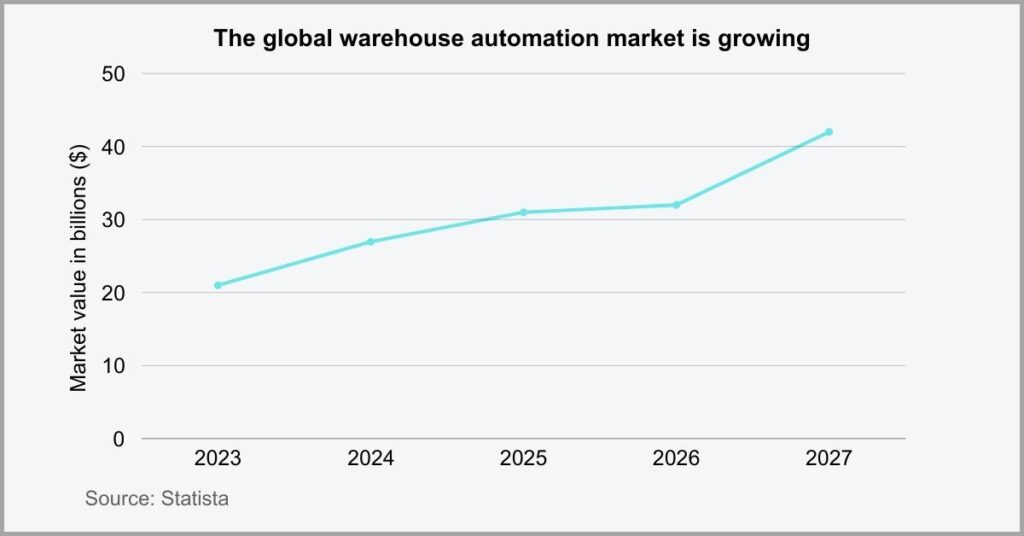
71) $23.44 billion was the size of the global warehouse automation market in 2023, compared to $26.96 in 2024. So growth was relatively stable in the past year, with demand having fizzled out following a spike brought about by the COVID pandemic. (Source – Statista)
72) By 2027, the worldwide global warehouse automation market will reach a value of $41 billion. If you’d like to make your warehouse business more competitive, now’s the right time to invest in these tools before the rest join in. (Source – Statista)
73) 80% of warehouses are manually operated with very little to no supporting automation. So despite the significant shift that we’ve noticed toward automation, there still remains a very long way to go. (Source – Mordor Intelligence)
74) 37% of the global warehouse automation market is based in North America. From the warehouse automation statistics I reviewed, it’s the region with the largest market share, probably fueled by the growing number of warehouses in the region. (Source – Precedence Research)
75) 80% of the revenue share of the global warehouse automation market in 2023 came from the hardware segment. In other words, most businesses are investing more in warehouse hardware and equipment than they are in software solutions. (Source – Precedence Research)
76) 51% of businesses have invested in the mobile barcode scanning segment of the warehouse automation market. These are basically portable technologies that let you scan and update inventory records on the move to boost efficiency. (Source – Extensiv)
77) 50% is the expected increase in robotic shipments in the warehouse automation market. This technology simply entails the use of drone robots to complete last mile deliveries, which is a strategy that can help you decrease shipping delays and costs. (Source – McKinsey)
78) 48% of logistics and fulfillment businesses plan to increase their investments in warehouse automation by less than $25 million. More specifically, they aim to spend more on robotics process automation and WMS systems. (Source – McKinsey)
79) 38% of automotive businesses said they plan to invest between $25 million and $99 million in warehouse automation. In the automotive industry, warehouse automation can help you improve inventory control particularly when it comes to managing vehicle parts. (Source – McKinsey)
80) 23% of businesses in the life sciences, healthcare and pharmaceutical niches said they’ll invest between $100 million and $499 million in automation. This represents one of the highest investment rates across industries. (Source – McKinsey)
IX. Statistics about WMS buyer trends
Looking for reliable and effective warehouse technology?
It can be very difficult when it comes to choosing a great transload WMS because there are so many options available, and your workflow may also have very unique services and needs such as transloading.
In order to help you get the right fit, I’ve gathered some more warehouse management system statistics for you:
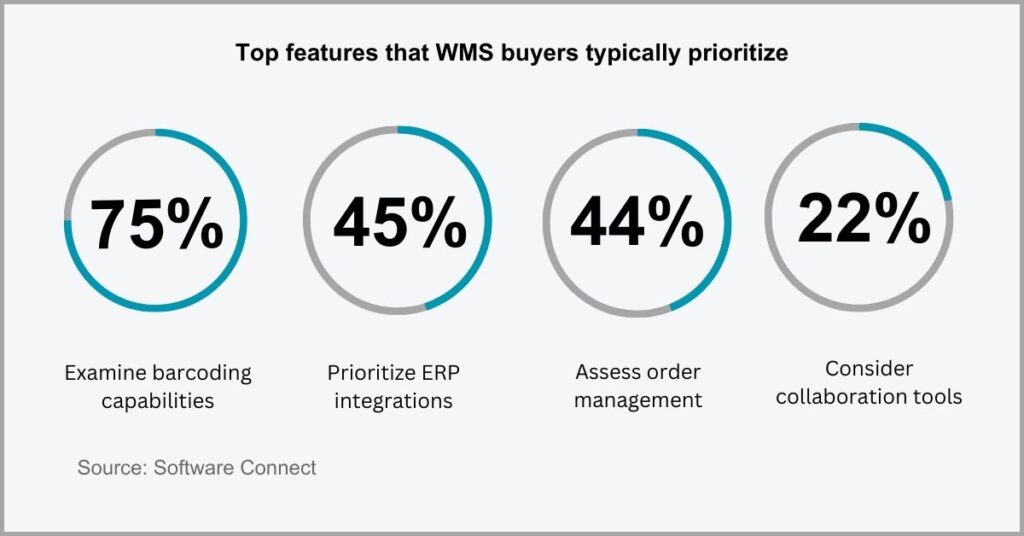
81) 3 in 4 buyers of warehouse management software want barcoding features. With this capability, you can greatly improve the speed and accuracy of inventory processing, which is one of the most important parts of your workflow. (Source – Software Connect)
82) 45% of businesses go for a WMS that can accommodate their enterprise resource planning system. When buying such tools, I advise that you go with a solution that integrates seamlessly with your existing technologies so you can hit the ground running. (Source – Software Connect)
83) 44% of warehouse management software buyers prioritize order management capabilities. With your businesses likely receiving orders from multiple channels, these features can help you prioritize and manage orders more efficiently. (Source – PRG)
84) 22% of logistics businesses are looking for WMS systems that can improve collaboration with vendors and suppliers. I recommend going for a solution with customer portals that help improve client communications. (Source – PRG)
85) 33% of companies said they want a software solution for their warehouses that can help them manage procurement. More specifically, they’d like procurement features based around purchase order and supplier management. (Source – PRG)
86) 30% of businesses admitted that a great warehouse management should facilitate demand planning. When you can accurately anticipate market demand, you’ll reduce the risk of supply chain disruptions resulting from stock outs. (Source – PRG)
87) $402,267 is the average budget for WMS systems for companies with 1,000 or more staff, while companies with 1 to 9 staff tend to dedicate $57,200. This data shows us the financial disparity across workflow sizes. (Source – Software Connect)
88) 28% of buyers are looking for a WMS for managing 2 warehouses while 26% aim to manage 3 or more. So these warehouse management system statistics indicate that most buyers are looking for WMS solutions with multi-warehouse tracking capabilities. (Source – DCV)
89) 73% of WMS shoppers are looking for barcoding as an inventory tracking feature with 7% prioritizing RFID for the same task. RFID is a wireless communication technology that enables you to track items in your inventory using special tags and a reading device. (Source – DCV)
90) 39% of buyers admitted to shopping for warehouse management software to get more advanced features, with 20% keen to replace an outdated system entirely. As a result, these are the two top motivations among warehouses for buying a WMS. (Source – DCV)
X. Warehouse management KPIs statistics
Setting key performance indicators is important.
They enable you to determine if the warehouse tech innovations you’ve implemented are working and whether other management strategies are bringing in the right results.
KPIs are very essential because they enable you to course correct and get the best ROI from your investments, and this is why I’ve compiled this data:
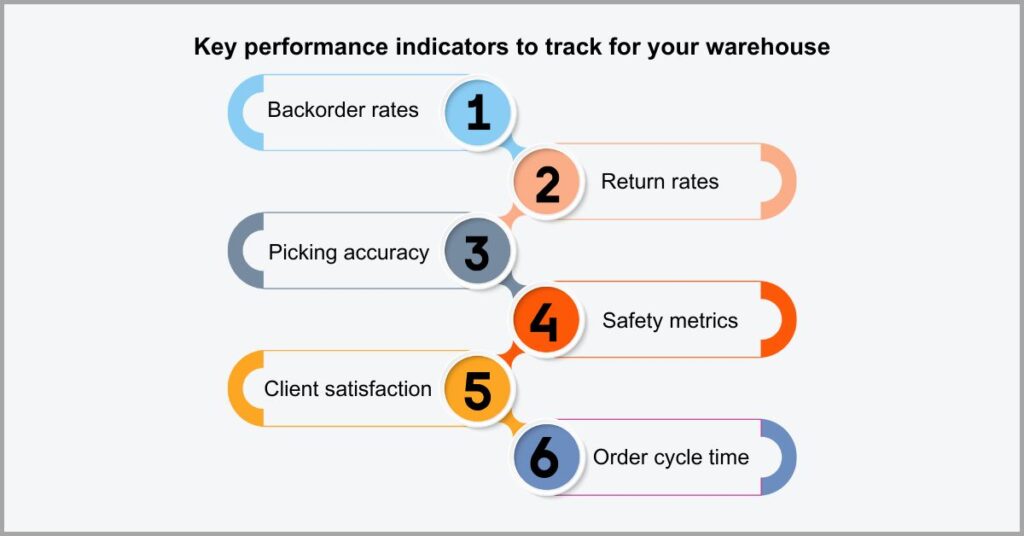
91) 48% of warehouses track orders fulfilled per hour when evaluating performances for their workflow. This can give you a great perception of your warehouse’s throughput so that you can identify and solve bottlenecks to turbocharge productivity. (Source – Logistics Management)
92) 84% of businesses monitor various warehouse worker productivity metrics in general for both temporary and permanent staff. Keeping tabs on staff productivity is essential to helping you get the best out of your personnel. (Source – Logistics Management)
93) 54% of companies use on-time shipping benchmarks to assess the efficiency of their operations. This directly affects customer satisfaction and repeat businesses, so it’s an important metric that I recommend you should track. (Source – Logistics Management)
94) 42% of floor workers cited exhaustion and fatigue as key warehouse challenges. Therefore, worker well-being ranks among important warehouse management statistics and KPIs you should track to decrease employee turnover for your warehouse. (Source – ProGlove)
95) 72% of warehouses said tracking workflow and process improvements is important for success. I couldn’t agree more because keeping tabs on these metrics allows you to create a formula for success that you can replicate across your workflow. (Source – ProGlove)
96) 26% of warehouses measure employee retention in 2024. So most logistics businesses don’t pay attention to this, however, measuring it can go a long way to improving staff loyalty and reducing your rehiring expenses. (Source – AutoStore)
97) 28% of businesses collect customer satisfaction rates for their fulfillment centers. It goes without saying that this metric is very important to track if you’d like to earn more repeat business, referrals and ultimately revenue for your warehouse. (Source – AutoStore)
98) In 2024, the average order picking accuracy rate is 99.15%. This is a great yardstick to measure the quality of your picking processes by, because it’s a rate that shows you’re making fewer errors, therefore decreasing returns & improving client satisfaction. (Source – Warehousing and Fulfillment)
99) Backorders can erode profits by up to $20 per fulfillment. These losses are caused by stockout scenarios, with average backorder rate across industries being less than 2% so this is a great figure to aim for. (Source – F Curtis Company)
100) 89% of warehouses tracked their performances in 2023 compared to 85% in 204. So while these warehouse system statistics point to a decline in performance tracking, many still recognize its importance and do so regularly. (Source – Warehousing and Fulfillment)
Conclusion
There’s a huge labor shortage in the warehouse industry.
Consequently, it can mean having to rely on a lean workforce to run your operations.
If your warehouse is severely understaffed, this can lead to slow order fulfillment, which in turn causes customer dissatisfaction and lost revenue.
A survey by Descartes revealed that 56% of supply chain leaders noted massive worker shortages particularly in their warehouse operations. Unfortunately, they say that the situation will get worse in the coming years.
With the warehouse automation statistics we’ve discussed, you can leverage the right technologies to plug labor shortages. In particular, I recommend getting a proven transload warehouse management software for this purpose.
Click here to start your free transloads.co trial to use state-of-the-art automation features to improve warehouse efficiency.
From inventory tracking to shipment monitoring, our software can automate various manual warehouse tasks to plug staff shortages & streamline your operations overall.

